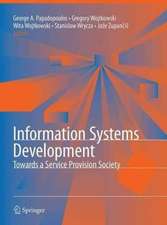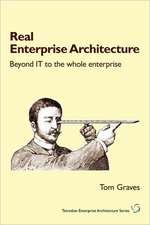Enterprise Architecture: A Pocket Guide
Autor Tom Gravesen Limba Engleză Paperback – 31 mai 2009
Preț: 97.83 lei
Preț vechi: 122.28 lei
-20% Nou
Puncte Express: 147
Preț estimativ în valută:
18.72€ • 19.60$ • 15.49£
18.72€ • 19.60$ • 15.49£
Carte disponibilă
Livrare economică 15-29 martie
Preluare comenzi: 021 569.72.76
Specificații
ISBN-13: 9781849280167
ISBN-10: 1849280169
Pagini: 54
Dimensiuni: 91 x 160 x 10 mm
Greutate: 0.05 kg
Editura: It Governance Ltd
ISBN-10: 1849280169
Pagini: 54
Dimensiuni: 91 x 160 x 10 mm
Greutate: 0.05 kg
Editura: It Governance Ltd
Cuprins
Introduction 1 Chapter 1: What is Enterprise Architecture? 3 Some definitions 3 Why enterprise architecture matters 4 Chapter 2: Business Drivers and Benefits 6 Layers of business benefit 6 Enterprise effectiveness 9 Enterprise agility 9 Chapter 3: Architecture Maturity 11 Ad-hoc development of architecture 11 Planned development of architecture 12 Chapter 4: The Architecture Team 14 The makeup of the team 14 The business role of architecture 17 Chapter 5: Architecture and Governance 19 Governance and standards 19 Architecture and IT governance 21 Architecture and corporate governance 22 Chapter 6: Frameworks, Methods and Tools 24 Architecture frameworks and methods 24 Architecture standards 28 Architecture toolsets 29 Chapter 7: Architecture in Practice 32 Preparing for architecture 32 The architecture cycle 33 Hands-off architecture 41 Engaging everyone 43 ITG Resources 45
Notă biografică
Tom Graves has been an independent consultant for almost three decades, in business transformation, enterprise architecture and knowledge management. His clients in Europe, Australia and the US cover a broad range of industries, including banking, utilities, logistics, engineering, media, telecoms, research, defence and government. He has a special interest in architecture for non-IT-centric enterprises, and integration between IT-based and non-IT-based services.
















